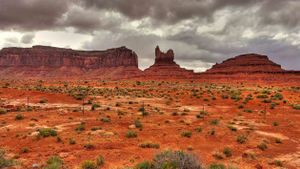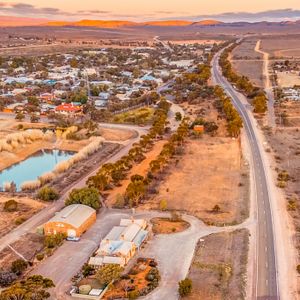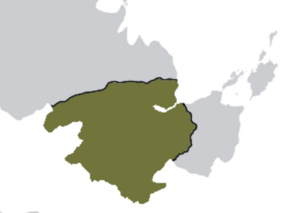Al Eazim Koura Desert
| Al Eazim Koura Desert | |
|---|---|
 | |
| Ecology | |
| Realm | Surotropical |
| Biome | Arid desert |
| Geography | |
| Countries | |
| Climate type | Hot desert climate |
The Al Eazim Koura Desert (Koraha Koura Nui in Tumish, Alsahra' Aldhahabia Aleazima in Arabic) is a vast and arid desert region that stretches across the eastern territories of Sconia and Tumland. This formidable desert is known for its harsh climate, vast sand dunes, and valuable oil reserves. It has played a significant role in the history and development of the regions it spans.
Contents
Geography and Extent
The Al Eazim Koura Desert covers a substantial portion of eastern Sconia and extends eastward into Tumland. It encompasses a diverse range of landscapes, from expansive sand dunes to rocky plateaus and barren stretches of land. The desert's boundaries are not precisely defined, but it is generally considered to reach from the east of Sconia to the eastern regions of Tumland.
Climate
The desert is characterized by an extremely arid climate. It experiences scorching temperatures during the day and frigid nights, with minimal annual rainfall. The lack of moisture and vegetation contributes to the desert's inhospitable conditions.
Natural Resources
Oil Reserves One of the most notable features of the Al Eazim Koura Desert is its substantial oil reserves. Beneath the vast expanse of sand lies a wealth of petroleum resources. These oil reserves have been a focal point of economic interest and geopolitical significance in the region.
Sconia and Tumland have made significant investments in oil exploration and drilling operations within the desert. These endeavours have yielded substantial revenue, allowing both nations to fund infrastructure development and social programs. However, the extraction of oil from this challenging environment requires advanced technology and substantial financial investment.
Minerals
In addition to oil, the desert is also believed to contain various mineral resources. Prospecting efforts have identified deposits of minerals such as gypsum, phosphate, and potash. These minerals have economic importance for the region and are extracted for various industrial purposes.
Inhabitability
The Al Eazim Koura Desert presents severe challenges to human habitation. The lack of accessible water sources, extreme temperatures, and limited vegetation make it an inhospitable environment. While some nomadic communities have historically traversed parts of the desert, permanent settlement has proven to be extremely difficult.
Sconia
In the Sconian portion of the desert, near its western edge, human habitation is almost non-existent. The extreme aridity and lack of infrastructure have deterred significant settlement. This part of the desert is often referred to as the "Sconian Wastes."

Tumland
Tumland, located to the east of Sconia, has made slightly more progress in establishing settlements within its portion of the Al Eazim Koura Desert. Some towns and small communities have developed near oil extraction sites, and limited agriculture is practised where water resources permit. Nonetheless, life in this region remains challenging, with inhabitants relying on advanced technology and resource transportation for survival.
Geopolitical Significance
The Al Eazim Koura Desert's oil reserves have made it a focal point of geopolitical tensions and cooperation between Sconia, Tumland, and neighbouring nations. Control over access to these valuable resources has influenced diplomatic relationships and economic partnerships in the region.
Conservation Efforts
Efforts to balance economic development with environmental conservation have gained momentum in recent years. Conservationists and environmental organizations are advocating for the preservation of fragile desert ecosystems and the mitigation of environmental impacts associated with oil extraction.
